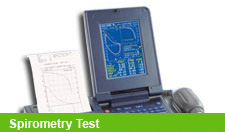Spirometry
Spirometry Test in Nashik
Who Should Have a Spirometry?
If you answer yes to any of the following questions, you should ask your doctor about having a spirometry test in Nashik:
Do you (now) or have you ever smoked?
Are you short of breath more often than other people?
Do you have a cough that does not go away? For example: daily coughing or the ‘morning’ cough?
If you cough, do you cough up mucus?
Do people around you smoke?
Do you work around chemicals and dust?
Does bronchitis or emphysema run in your family?
Do you wheeze (a whistling or squeaky sound when you breathe)?
At Dr. Mutha Hospital – a trusted center for Pulmonary Function Test (PFT) in Nashik – we encourage early diagnosis for better respiratory health.
What Does a Spirometry Tell My Doctor?
Spirometry is a simple, non-invasive breathing test that can be performed right in your physician’s office. It measures the amount of air you can forcefully blow out after taking the deepest breath possible.

This test provides two critical values that help diagnose obstructive and restrictive lung diseases such as asthma, COPD, or interstitial lung disease.
1. FVC – Forced Vital Capacity
The total volume of air you can forcefully exhale.
Assesses lung size, how well lungs expand/contract, and how effectively the air passages function.
Reduced FVC is often linked with restrictive lung disorders such as ILD (interstitial lung disease).
2. FEV1 – Forced Expiratory Volume
The volume of air blown out in the first second of exhalation.
Considered “normal” if >80% of predicted value.
Reduced in both obstructive and restrictive lung diseases.
3. FEV1/FVC Ratio
A critical measurement to distinguish between obstructive and restrictive lung diseases.
Normally around 70%-80% in healthy individuals.
Decreases in COPD and asthma; stays near-normal in restrictive diseases.
What You Need to Do Before the Test?
To prepare for your spirometry test in Nashik, follow these guidelines:
Wear comfortable, loose-fitting clothing.
Avoid using inhalers before the test (unless advised otherwise).
There are short-acting and long-acting bronchodilators, so consult your doctor regarding how long to avoid them.
If you do use your inhaler before the test, inform the technician about:
The name of the inhaler(s)
Dosage and number of puffs
Time of usage
What Happens During the Test?
The technician will ask you a few questions to calculate your predicted lung function based on:
Age – Lung function naturally declines with age.
Height – Taller individuals usually have larger lungs.
Sex – Women generally have smaller lung capacities than men.
Procedure:
You will either sit straight or stand.
A nose plug may be used to ensure airflow only through the mouth.
You’ll be instructed to:
Take in a deep breath
Place the mouthpiece into your mouth, sealing it tightly
Blast the air out quickly and forcefully
Continue blowing until instructed to stop
The test will be repeated multiple times to ensure accurate readings. In some cases, spirometry may be done before and after using a bronchodilator to see how well your airways respond to medication.
Ready to get our medical care? We’re always wait for serve you, Make an Appointment.
Appointment
Our Pricing Packages
- Neurology Care
- Medical Care
- Child & Old Care
- Dental Care
- On-Time Delivery
- Neurology Care
- Medical Care
- Child & Old Care
- Dental Care
- On-Time Delivery
- Neurology Care
- Medical Care
- Child & Old Care
- Dental Care
- On-Time Delivery
